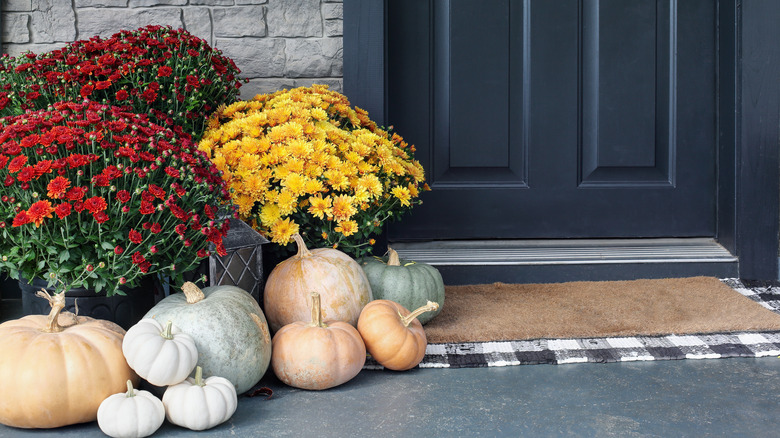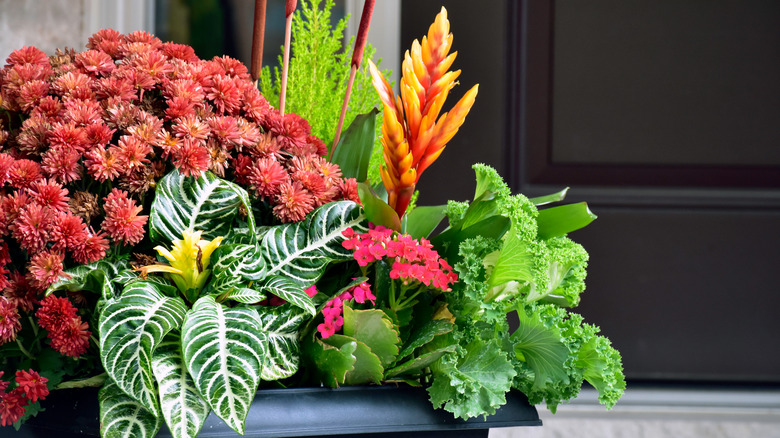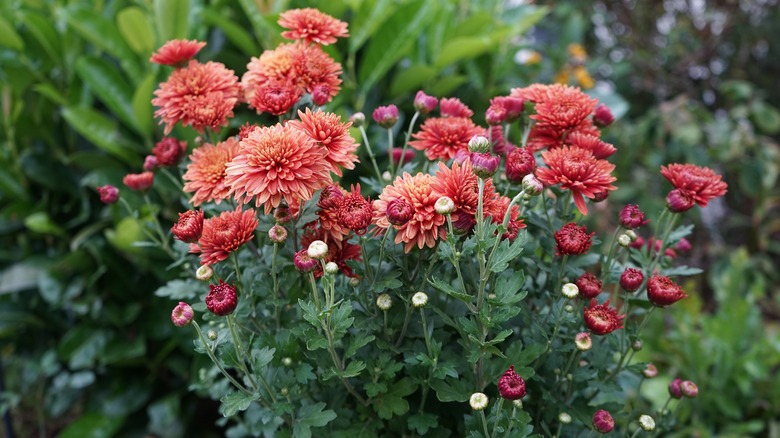When Is The Best Time To Put Out Your Fall Mums?
As the days grow shorter and kids return to school, chrysanthemums start to appear on the shelves of many garden retailers. These hearty blooms are a favorite of many gardeners, and they've been used to symbolize autumn since their cultivation in ancient China, according to florists at Appleyard Flowers. For gardeners, it can be tempting to splurge on a bunch of chrysanthemums and usher in the start of fall. However, when it comes to planting mums, it may be better to wait until you are well into the autumn season.
Mums produce the most blooms when they are kept between 65 and 70 degrees Fahrenheit, but the length of daylight also plays a role in plant health (via Michigan State University). The best combination for mums is to have both cool temperatures and short days. Early-season varieties can still withstand higher temperatures if the days are short, meaning there are fewer than 10 hours of sunlight. Sunlight duration is not as important for late-blooming varieties, but all mums do better when kept in cool temperatures. Unless you plan on replacing your mums throughout the season, it may be best to wait until autumn weather officially rolls in.
How long do mums last?
There are two main varieties of chrysanthemums: florist mums and garden mums. Florist mums are planted in the fall and generally bloom for about two to three weeks (via Best Weed and Feed). With perfect temperatures, plenty of water, and proper trimming, chrysanthemum blooms can last even longer. Once the plant goes through its blooming phase, florist mums are not likely to bloom again. If you experience an unusually cool summer, it's best to remove any early blooms from your florist mums. This will ensure that the flowers arrive only when you want them to, during the fall season. Unfortunately, florist mums don't typically survive through winter, so you'll need to replant them every year.
Mums are typically seen as flowering annuals, but they are actually herbaceous perennials, meaning they will return each year if they have time to establish root systems in their soil (via All About Gardening). Garden mums are slightly different from floral mums. With the proper care, garden mums planted in the spring or summer will establish roots in the soil long before winter. Unlike floral mums, garden mums will return each year as long as their roots have been established. Garden mums can also bloom more than once, providing colorful flowers throughout the summer and fall.
How to get the most from your mums
Chrysanthemums are generally very durable plants, but gardeners should follow some special care requirements to keep them happy. Mum will thrive best between USDA climate zones 5 through 9, according to Best Weed and Feed, and they prefer about 6 hours of direct sunlight daily. After purchasing your mums, you will need to repot or plant them with plenty of space for roots to grow; cramped roots can lead to problems with water absorption. It's crucial to keep your mums hydrated, especially if temperatures are still warm in your area. However, be cautious to only water the soil and avoid soaking the blooms, floral retailer FTD by Design warns. Wetting your whole plant can cause diseases.
The most important tip for prolonging your mums is to deadhead old flowers. Deadheading is the process of pinching or clipping away old, withered blooms to encourage more fresh bloom growth. This will ensure that your plant's blooming phase lasts as long as possible and that the flowers are full and healthy. Removing old flowers can also help the plants focus on root growth, leading to healthier, bushier chrysanthemums. With a little special care and attention, chrysanthemums can easily become an autumn tradition in your home.


